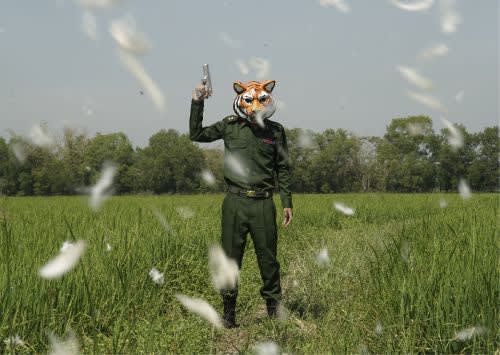In the Discoveries sector, young artists from Myanmar to New Zealand will shed light on what defines us in surprising new ways
It’s not just millennials who think that dealing with one’s identity is as rewarding as it is challenging. In Art Basel Hong Kong’s Discoveries sector, which is dedicated to emerging positions, artists look closely at what makes us who we are: our culture, gender, time, history – even death.
Take Japanese artist Aki Inomata. In her series ‘Why not Hand Over a “Shelter” to Hermit Crabs?’, presented by Tokyo’s Maho Kubota Gallery, she does exactly that, creating micro-habitats for the ever-adaptable crustacean. Her small sculptures are modeled after different monuments and cityscapes, such as Bangkok’s or her hometown’s. Hermit crabs, however, do not inhabit their chosen homes for a very long time, usually looking for a more comfortable space as soon as they have outgrown their current one. In doing so, do they remain the same being?, Inomata asks. How much is one defined by one’s living arrangements? In another work, the artist makes an octopus toy with the shell of an ammonite, a prehistoric cousin of the mollusk that went extinct millions of years ago. These interactions are, of course, quite allegorical; the creatures activating Inomata’s pieces stand in for complex ideas about origin, belonging, and fluid nomadism.
Cities as complex and multifaceted environments lie at the center of Lena Henke’s upcoming presentation with Galerie Emanuel Layr. The German artist’s interest in the relationship between gender, space, and economics has led her to produce a series of sculptures vaguely mimicking the outlines of New York City buildings. Each one of these stainless-steel towers features a figurine resembling a female body – a hint at the commodification of both spaces and bodies in an environment associated by some with total freedom, and others with crushing alienation. Henke is also looking into the way Chinese investors have been investing vast sums of money in Manhattan real estate over the past years. This invisible transfer of ownership is reflected in the artist’s focus on the skyscraper as a status symbol. At the Viennese gallery’s booth, Henke’s foray into New York City will be extended through a series of wall-based leather works, depicting structures such as tree trunks or pathways found in the city’s main green lung, Central Park.
Savia Mahajan’s work tackles both absence and presence. The Mumbai-based artist’s practice addresses the big questions – in essence, life and death, and what arises or disappears with it. For this project, Mahajan uses books, fire, chemicals, and clay: She coats the volumes in the muddy material and then fires them in a kiln. What remains are the rough, distressed blueprints of untold stories that have combusted, shells of shells. However, one can assume that the memory of a novel, a poem, or a recipe survives in the minds of those who have read it. What’s more, Mahajan’s doesn’t destroy, she merely transforms one knowledge vessel into another, almost fossilized form. Her sculptural musings on memory, loss, and subjectivity will be on view at Tarq’s booth, alongside a series of works on paper.
Culture, taste, and queerness are the subjects of Imogen Taylor’s paintings. Brought to Art Basel Hong Kong by Auckland gallery Michael Lett, her acrylics on burlap are sprinkled with references, ranging from obvious to delightfully discrete. At first glance, you’d be likely to picture the colorful canvases in a slick mid-century modernist home, so harmonious and smooth are their palette and composition. But like skilled drag kings, the paintings cheekily counteract the idea of conventional ‘tastefulness’ they first appear to embody. By progressively revealing disruptive elements, they create ‘links between the lexicon of modernism and queer theory’ says Andrew Thomas, Partner and Director at Michael Lett. Protuberances, cigarette butts, and holes of different sorts appear behind Taylor’s controlled lines as sassy suggestions of queerness. Suddenly, one realizes that her works would also make sense in an environment more raunchy than a conventional 1960s living room.
Burmese artist Moe Satt also subverts symbols and norms. His works, which explore the codified visual language around ideology and power, will be shown in Hong Kong by Bangkok’s Nova Contemporary. ‘Not only is Moe Satt an emerging artist from South East Asia,’ says the gallery’s founder and director Sutima Sucharitakul, ‘he also represents the voice of a new generation that has witnessed some of the biggest socio-political transformations in his native Myanmar.’ With the country’s attempts at democratization came the question of identity: What should society retain from its turbulent history? In his sculptures and videos, Moe Satt mediates these issues through seemingly mundane objects, gestures, or political motifs. Childhood games and simple tools inspire absurdist works that examine the consequences of political uprising, violence, and erasure in the artist’s home country.
Discover more artists and galleries participating in this year’s Discoveries sector here.


